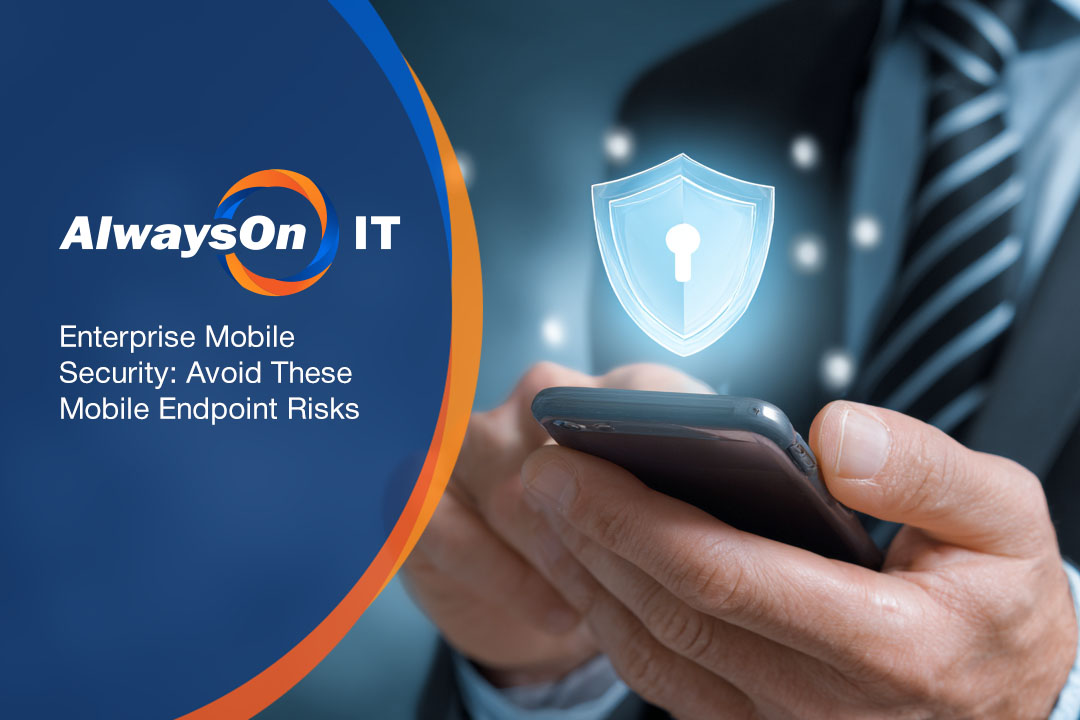November 14, 2025

Securing mobile devices in your business isn’t optional anymore. With more employees working remotely and using smartphones or tablets for work, enterprise mobile security is a must. In this blog, you’ll learn what enterprise mobile security is, why it matters, and how to protect your business from common mobile threats. We’ll also cover key components, best practices, and how to manage mobile device security effectively.
[.c-button-wrap2][.c-button-main2][.c-button-icon-content2]Contact Us[.c-button-icon2][.c-button-icon2][.c-button-icon-content2][.c-button-main2][.c-button-wrap2]
Enterprise mobile security refers to the systems and strategies used to protect mobile devices like smartphones and tablets that access company data. These devices are often used by employees to check email, access files, or run apps tied to business operations. Without proper security, they can become easy targets for cybercriminals.
As mobile device use grows, so does the risk. Mobile threats can include malware, phishing attacks, and unauthorized access to sensitive data. Enterprise mobility adds convenience, but it also increases the number of endpoints that need protection. That’s why mobile device management is essential—it helps control, monitor, and secure every mobile device connected to your network.

Many businesses overlook key areas when setting up mobile security. Here are some common mistakes that can leave your company exposed:
Mobile devices are endpoints too. If you’re only securing laptops and desktops, you’re missing a big part of your network. Mobile endpoint security tools help detect and block threats before they reach your data.
Apps often request access to contacts, location, or files. If employees install apps without checking permissions, they could unknowingly expose company data. Always review app settings and limit unnecessary access.
Simple or reused passwords make it easy for attackers to break in. Enforce strong password rules and use multi-factor authentication (MFA) to add another layer of protection.
Relying on traditional antivirus software isn’t enough. Mobile threat defense tools are designed to detect threats that target mobile devices, like SMS phishing or malicious Wi-Fi networks.
Outdated operating systems and apps are common entry points for hackers. Set devices to update automatically or schedule regular checks to ensure everything is current.
Even with the best tools, human error can lead to breaches. Train your team on how to spot suspicious links, avoid risky downloads, and report issues quickly.
A strong mobile security setup offers more than just protection. Here’s what you gain:

Mobile devices are often the weakest link in enterprise security. They’re easy to lose, often used on public networks, and can be infected through simple actions like clicking a bad link. Mobile threat protection tools help detect and block these risks in real time.
These tools can scan apps for malware, alert users to unsafe Wi-Fi networks, and block phishing attempts. They also give IT teams visibility into device health and usage. Without this level of protection, your business could be exposed to data breaches, financial loss, or legal trouble.
A good mobile security plan includes several moving parts. Here’s what you need to build a strong defense:
MDM tools let you control which devices can access your network. You can push updates, wipe lost devices, and enforce security settings from one dashboard.
EDR tools monitor mobile endpoints for signs of unusual behavior. If a device starts acting suspiciously, the system can isolate it or alert your IT team.
Only allow apps that meet your security standards. Use app wrapping or containerization to separate work data from personal use on employee devices.
Encrypting data on mobile devices ensures that even if a device is lost or stolen, the information inside stays protected.
Limit access to sensitive data based on user roles. Not everyone needs access to everything. Role-based access helps reduce risk.
Review your mobile security setup regularly. Make sure it meets industry standards and adjust policies as needed.

Start by identifying all mobile devices that connect to your systems. This includes company-owned and personal devices used for work. Next, choose a mobile device management solution that fits your needs. Look for one that supports remote wipe, app control, and real-time monitoring.
Then, set clear policies for device use. Define what’s allowed, what’s not, and what happens if rules are broken. Train your employees so they understand the risks and how to stay safe. Finally, test your setup regularly and update it as threats evolve.
Following best practices can help you stay ahead of threats. Here are some to keep in mind:
These steps can reduce your risk and keep your mobile workforce secure.

Are you a business with 20 or more employees looking for a reliable way to manage mobile device security? If you're growing and need to protect sensitive data across multiple devices, we can help.
At AlwaysonIT, we specialize in helping businesses secure their mobile endpoints without slowing down operations. Our team offers mobile device security management solutions that are easy to use and tailored to your needs. Let us help you protect your people, your data, and your business.
[.c-button-wrap2][.c-button-main2][.c-button-icon-content2]Contact Us[.c-button-icon2][.c-button-icon2][.c-button-icon-content2][.c-button-main2][.c-button-wrap2]
The biggest risk is unsecured mobile devices accessing company data. Without proper mobile device management, these devices can be lost, stolen, or infected with malware. This creates a direct path for attackers to reach your business systems.
Mobile security tools help reduce this risk by enforcing policies, encrypting data, and monitoring device activity. For small businesses, investing in these tools is essential to protect sensitive data and maintain enterprise mobility.
Using a centralized mobile device management platform makes it easier. These systems let you control settings, push updates, and monitor devices from one place. You don’t need to manage each device manually.
This approach supports enterprise mobile security by giving your IT team visibility and control. It also helps enforce mobile security policies across all devices, whether they’re company-owned or BYOD.
Mobile devices are endpoints just like desktops or laptops. If they’re not secured, they can be exploited to access your network. Endpoint security tools detect threats and respond quickly to stop them.
This is especially important for businesses with remote teams or a mobile workforce. Protecting every endpoint ensures your enterprise stays secure, no matter where employees work from.
Your policy should cover device usage rules, app installations, password requirements, and what to do if a device is lost. It should also define who can access what data.
Clear policies support mobile device security management and help employees understand their responsibilities. This reduces the chance of accidental data leaks or security breaches.
Yes. Some apps collect more data than they need or contain hidden malware. If employees install unsafe apps, they could expose your network to risk.
To reduce this risk, use mobile threat protection tools to scan apps and block harmful ones. Only allow apps that meet your enterprise security standards.
Start by requiring strong passwords and enabling encryption. Use mobile device management tools to enforce security settings and monitor usage.
Also, train your mobile workforce on safe practices, like avoiding public Wi-Fi and recognizing phishing attempts. These steps help protect your business from threats that target mobile devices.